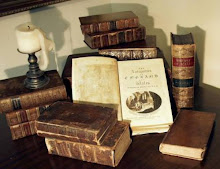Several Dear Readers have commented on the dreams and joys of owning a bookshop. For a book-fancier such comments are undoubtedly true. Yet, unless one is independently wealthy or Bernard Black (see Chapter Seventy-Six), owning a bookshop also entails duties of business, such as paying the bills, keeping inventory records, complying with regulations and laws. And for a small independent operation, your Bibliothecary not only gets to acquire the books, we also get to wash the windows, vacuum the floors, answer the telephones, and take out the trash.
On average once a week we hear from patrons how nice our bookshop smells. A few times someone elaborates that so many other used bookstores smell musty, and ours doesn't. Most books are made out of organic material, and in order for them not to rot away, they must breathe. Musty certainly is not a good smell for a bookshop.
A few days ago we began to shelve our newest acquisitions in the "Newest Arrivals" section. This involved first moving out some of the older new acquisitions, and placing them in their proper category in the shop. One such book was a title by Isaac Asimov. We carried it to the "Science Fiction" section, found the A's, and just as we were about to slide it between two of its brethren, we noticed three Asimov hardcovers with mildew on the top edge near the spine. That's odd, we thought, we don't remember this condition existing when we shelved these books. Nevertheless, we quickly removed them from the shelf and banished them to the dumpster.
The spores of fungi that become mould or mildew are always present in the air and settle onto surfaces to feed when there is sufficient moisture. Basically, mould and mildew eat library materials. They excrete digestive enzymes that allow them to eat starches and cellulose so they can grow and produce more spores. As mildew grows, it leaves a musty
odor; it discolors fabrics, and sometimes eats into them until the fabrics rot and fall to pieces; and it can irreversibly stain books and paper. This was definitely something that is not welcome in our bookshop.
With the flop of our science fiction sale late last year, we have been left with that category exceeding its boundaries, and crowding out the "Adventure" section. So, with a mind toward correcting this imbalance, and restocking the adventure titles, we began to cull the science fiction sections from seven down to six. Beginning with the A's, we almost immediately discovered all the books, in a vertical column in line with the three afflicted Asimov volumes, were being attacked by mildew.
There is a stain in the corner of the ceiling of our shop that was dry and dormant when we moved in. Apparently there had been recent activity in that spot, because the books below it were feeding the mildew, were stuck together, were bulging with damp. The shelves also had mildew. Mildew is like cancer, and will spread if not removed, so we immediately began the Emergency Response Procedures. Books flew to the floor two handfuls at a time. When a nice pile of over one hundred volumes had taken form in the aisle, two patrons walked in the door. Of course, they were interested in Science Fiction.
How does a book-fancier keep the musty smell from a bookshop? By being relentless, and having a policy as clearly stated as one for returns or trade-ins. We had no interest in risking a spread of the fungus, and so instead of attempting to clean and reclaim the books, we destroyed them. Once that had taken place, clean-up could begin.
The first step to conquering mildew is to remove the moisture. This meant for several days we let the empty shelves air out, so that the mildew would slowly stop growing. Once dormant, it takes on a powdery form, which can be dusted away at the risk of releasing some spores back into the air. We vacuumed. After this, shelves and floor must be washed, for which we used an old rag soaked in a mixture of one gallon of warm water and one cup of bleach. Once the shelves are allowed to dry again, we must check to see that the mildew has been completely eradicated. When it has, a new coat of varnish is probably not a bad idea. Once again, we let it dry, and then, at long last, our books may return to their restored home.
Prevention is the best mildew policy. If things are kept clean, well-ventilated and dry, your chances of having mildew are greatly lessened. The National Library of Australia recommends a temperature range of 66 to 73 degrees Fahrenheit; the University of Florida notes that a relative humidity less than 62% stops all chances of mold growth. Finally, when one brings home those new acquisitions, it is always best to quarantine them. At the Georgia State Archives they maintain a "dirty room" where new acquisitions are checked for
insects and mold and treated if necessary before being added to the stacks. Keeping new aquisitions away from one's collection until one knows they are clean ought to be as routine as scanning one's email for viruses before opening, because the consequences could be just as insidious.
Being eaten alive by mildew is a fate no book-fancier would ever wish upon any book, not even The Bridges of Madison County. And until mildew comes out with lavender-, cinammon-, or baby powder-scented versions, we refuse to admit it's smell into our bookshop.
Subscribe to:
Post Comments (Atom)


"until mildew comes out with lavender-, cinammon-, or baby powder-scented versions"
ReplyDeleteNow there's a nice project for an aspiring genetic engineer!